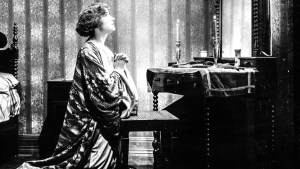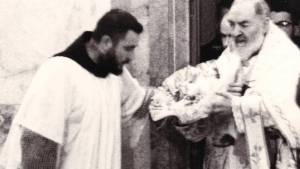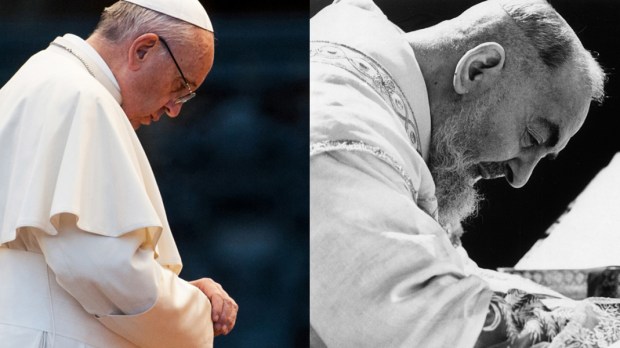The Jubilee Year in honor of the 100th anniversary of St. Pio’s arrival at San Giovanni Rotondo is drawing to a close.
Pope Francis sent Cardinal Angelo Amato, prefect of the Congregation for Saints’ Causes, to San Giovanni Rotondo, Italy, to preside over the ceremony for the closing of the Jubilee Year on July 28.
In this context, let’s take a moment to look back at the Holy Year of Mercy, when Pope Francis highlighted Padre Pio as an example of a priest and confessor, and a full-time “servant of mercy” who practiced the “apostolate of listening” and prayer, sometimes to the point of exhaustion.
Lessons from Padre Pio on how to pray well
Here, we offer some lessons from St. Padre Pio, in the words of Pope Francis during a Jubilee audience for Prayer Groups of Padre Pio in St. Peter’s Square. (February 2, 2016). The Pontiff starts by saying that prayer “is not a nice practice for finding a little peace of heart; nor is it a means of devotion for obtaining useful things from God.” If that were the case, it would be an act of “subtle selfishness.”
On the contrary, as he goes on to explain, it involves leaving our own egoism behind, and helps us keep alive true interior happiness.
Prayer is, in fact, “a spiritual work of mercy, which means bringing everything to the heart of God,” Pope Francis explained.
“St. Pio never tired of welcoming people and listening to them, expending time and energy in order to spread the perfume of the Lord’s forgiveness. He could do this because he was always connected to the source: he ceaselessly quenched his thirst with Jesus Crucified.” – Pope Francis, February 2, 2016
1. Prayer isn’t aspirin.
Prayer isn’t an aspirin you can take to feel better, or a transaction we do with God to get what we want. Pope Francis explains that Padre Pio taught, with his life, that prayer is a spiritual work of mercy, entrusting everything to God, the Father. It is a gift of faith and love.
2. Prayer is like bread.
Prayer is necessary to sustain us, “just as bread is.” Our attitude when we pray must be one of trust and confidence: “I entrust this to you… Take it, You who are the Father,” so that God will take care of those things we carry in our hearts that concern us.
3. Prayer is a key that opens God’s heart.
Prayer, as Padre Pio loved to say, is “the greatest weapon we have, a key that opens the heart of God.” Pope Francis adds, “It is a simple key. The heart of God is not ‘heavily guarded’ with many security measures.”
4. Prayer is the strength of the Church.
Pope Francis explains that the heart of God is opened by prayer because He is a Father who cannot resist the voice of his children.
Thus, prayer “is the Church’s greatest strength, one which we must never let go of, for the Church bears fruit only if she does as did Our Lady and the Apostles, who ‘with one accord devoted themselves to prayer’ (Acts 1:14), as they awaited the Holy Spirit.”
5. Prayer is the recipe for joy
The Holy Father, remembering St. Pio, teaches that constant prayer is a part of fighting the good fight. “Otherwise, we risk looking elsewhere for support: relying on means, on money, on power.”
Lastly, prayer keeps evangelization alive, and the joy that enlightens the heart and keeps it from growing dull.
The pope then ended by declaring that the key to a joyful heart is prayer.

Read more:
Why pray when praying doesn’t work?
Padre Pio
St. Pio was a Capuchin friar who dedicated his life to the salvation of souls. He was born in 1887, joined the Capuchin order at the age of 15, and was ordained to the priesthood in 1910. On July 28, 1916, he was sent to the friary at San Giovanni Rotondo, where he remained until his death.
In 1918, after celebrating Mass, he received the stigmata—wounds mirroring those of Christ, which Padre Pio bore on his hands, feet, and side, and which accompanied him for more than 50 years. This phenomenon would attract an endless procession of journalists and doctors. Above all, however, the stigmata attracted many of the faithful.

Read more:
Padre Pio’s secret wound was more painful than the stigmata
On February 5, 2016, the relics of the famous Capuchin arrived at the Vatican to be presented for the veneration of the faithful for nearly a week, as part of the Jubilee of Mercy.
A sea of faithful experienced that moment with great devotion—many were moved to tears—and then they accompanied his relics, amidst a crowd full of devotion, along the Via della Conciliazione, the main road leading out from St. Peter’s Square.

